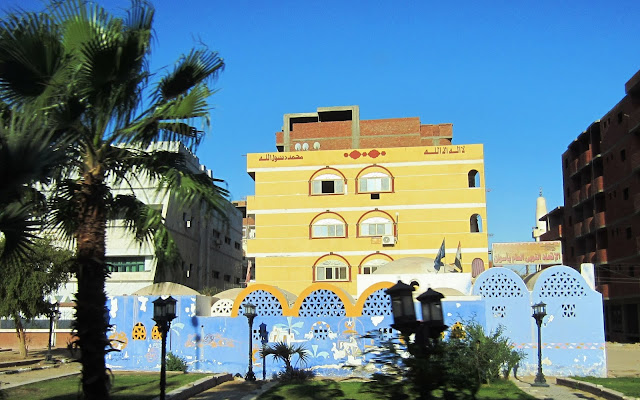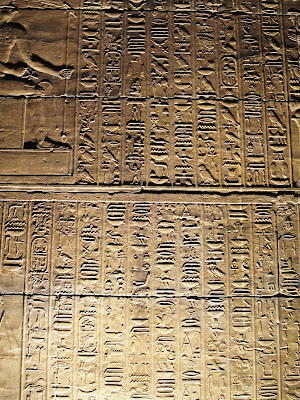Before we began our cruise up the Nile, we spent a night and day docked in Aswan, a city in the southern quarter of Egypt known for being one of the hottest, driest, sunniest cities in Egypt. Luckily, we were there in relatively cool March.
We were headed for the Temple of Philae about eight miles from the docks. The first thing we saw as we pulled out onto the main road was a shepherd, his dogs, and a flock of sheep. NOT a sight we are familiar with in larger American cities:
We drove past many things we would love to have taken a look at, such as the Archangel Michael's Coptic Orthodox Cathedral:
Wikipedia provides these two photos of the interior:
We were disappointed that we never got to see inside a Coptic church. The Copts are the largest Christian community and the largest religious minority in the Middle East, comprising about 10% of the total population. This church--or an even larger one in Alexandria--would be high on my list if we ever make a return visit.
Some of the architecture in Aswan was unique, and sometimes it was downright bizarre. This one reminded me of a rich movie star's house in Beverly Hills:
This building, with it's sky-blue wall decorated with Egyptian designs and the Arabic writing on the top of the building is also very unusual, but at least it looks like a more local design:
Everything seemed to be under construction, but I think it may be that like the unfinished buildings we saw in the Balkans, people build as they have the money. In Egypt, the buildings often had a finished, probably livable ground floor, and several "potential" floors above:
I'm not sure why Facebook would need a storefront, but it appears to have one in Aswan:
Another (relatively) familiar sight:
The typical gas station looks very much like an American gas station:As of today, the price of gas in Egypt is about $1.36/gallon, while the price at my local ARCO is $3.79/gallon.
The typical Man on the Street doesn't dress much like an American:
We were in Aswan on a Friday, the holy day for Muslims, when there is no work (except tourism) or school, and everyone goes to the mosque. These long garments are most common on Fridays, much like how we wear our Sunday clothes to church.
Eventually we arrived at the ticket booth for Philae. One of the nice things about being with a tour group is that they handle all our tickets . . .
 |
| 60 LE = $7.65 |
. . . and related expenses. Philae is on an island in the middle of the Nile, so I'm not sure how a ticket holder would get there without a boat. I'm surprised they don't "includ" the boat ride in the ticket price.
Our captains were waiting for us:
They were lined up like cabs outside JFK Airport, a long string of hopefuls:Note all the boats in the background:
When I see this picture of five innocent travelers . . .
. . . I can't help but think of this song:
Luckily, "the weather [never] started getting rough."
Prior to this trip my only association with "Aswan" was "Dam." There are actually two Aswan Dams, the High Dam and the Low Dam. The Low Dam was the first one built in 1898-1902 as a way to control the annual late-summer flooding of the Nile. One unfortunate side effect of the dam was that it submerged Philae for most of the year.
 |
| 1906 photo from Wikipedia showing Philae surrounded by water. |
 |
| 1908 photo from Wikipedia |
In the 1960s, work was begun on a second dam, called the High Dam, which would permanently submerge Philae and twenty-two other archaeological sites. UNESCO sponsored a visionary international rescue operation, taking apart the sites block-by-block (about 40,000 blocks, actually, weighing about 20,000 tons) and rebuilding them at safe distances from the new reservoirs. Philae, which was originally built on an island, was moved to the nearby island Agilkia, which was reshaped to mimic the original island as closely as possible and has since been renamed Philae Island. The new site was opened to tourism in 1980.
It's quite a story, but it's quite a site!
I always think of Egyptian ruins as being built a couple of thousand years BC, which is when the Great Pyramids were built. Construction of Philae, however, began around 380 BC, still plenty old, but not within the boundaries of my stereotype.
The first structure that greets visitors is the iconic Trajan's Kiosk, built in the 2nd Century AD by the Roman Emperor Trajan. That was another surprise. Roman emperors built Egyptian temples used to worship Isis? Clearly, I had a lot to learn.
In its original location, this structure was the main entrance into the temple from the river:
The main structure on the island is the Temple of Isis. The goddess Isis has different roles in different cultures.To some she is the sister-wife of the great god Osiris and mother of Horus, the falcon-headed deity. To most she is the goddess of health, marriage, motherhood, and wisdom. Her name means "throne," and she is often shone wearing a throne as a headdress. She is known for using her magical powers to gather the scattered pieces of the body of her husband after his murder by his brother Set and restore him to life.
During the era of Roman rule in Egypt, pilgrims from all over the Mediterranean would come to Philae on a pilgrimage, and the island flourished as a worship center until it was shut down by the Byzantine emperor Justinian in the 6th century AD. For a while it even served as a Christian church devoted to Mary.
The entrance of the Temple of Isis is 150-foot-tall dual towers, an architectural style we would see again at Ramses III's temple and at Luxor.
The remains of the foundation of a small chapel are at the base of the tower:
Another set of towers is on the other end of the temple:
In the forecourt before the main entrance to the Temple of Isis, columns stand like sentries, each wearing a slightly different uniform:
Each capital is unique and ornamented with fruits and flowers. The columns are covered with hieroglyphics:
These carvings in the columns have survived weather, Christian redecorating, and Nile River flooding for over 2,000 years.Our guide kept saying, "Yeah, this is great, but wait until Karnack or Luxor." However, there is nothing like the first time you see a thing--in this case Egyptian structures and hieroglyphics--to make a strong impression. We were in awe.
The locals were not quite as overcome as we were:
Everywhere we looked there was something incredible to see. A small building on one side of the courtyard was used by the temple priests:Another colonnade, this one almost perfectly preserved:
Columns in front of what is called "The Birth House" are topped with the face of Hathor.
The detail on the capitals and the carving on the beam above them are spectacular:
We made our way into the temple proper:

I'm pretty sure the ancient Egyptians didn't have skylights:
Later in the trip I purchased a lotus-shaped pendant that reminds me of these exquisite capitals:
Another version of the lotus is found on the walls:
Figures and hieroglyphics are everywhere, even on the stone forming the top of a doorway:
Most columns are covered from floor to ceiling with inscriptions:
 |
| "Here's a cake I baked for your birthday . . . " |
Originally, these pictures were painted, but time and the flooding Nile have washed away the color:
One doesn't have to look far to imagine the colors that were used:

Wikipedia gives this image of what Philae may have looked like in all its glory:
A series of doors led us deep into the inner sanctum:
Occasionally we saw signs of the Christian invasion of this space:
By the time we got to the last doorway, our heads were spinning with mysterious images, symbolism, and ancient history.
The room at the end of the succession of antechambers is the Sanctuary of Isis, or what we might call "the holy of holies."The walls here are just as ornate, although the lighting is much dimmer:
In the center of the room is the original pedestal that once held a statue of Isis, or perhaps her sacred barque used in ceremonies and processions:
We had several "Indiana Jones" experiences in Egypt, this first excursion to an ancient temple being one of them. I almost expected snakes to appear or a giant stone to start rolling through the chambers.
Time to go back out into the sunlight:
We took a minute to view the Kiosk of Nectanebo, the oldest structure on the island, built in the 4th century BC to honor a pharaoh who founded the last native dynasty of Egypt:
Everything seemed so old. Well, almost everything. We did note some more recent additions in a few different places on the island, such as this inscription referencing Napoleon Bonaparte (see top line) whose French army had recently conquered Alexandria. This graffiti was inscribed in 1799.
Even more recent graffiti has dates from 1823 to 1872:
We spent some time enjoying the view from the broad deck. Steps around the island called "nilometers" were used to judge the depth of the Nile during the flood season and to predict the harvest. Each step was about 20 cm. If the water was too low, there would be a famine. If it was too high, crops would be destroyed. Now that the Aswan dams regulate the water level, nilometers are obsolete.
For some reason I always pictured the Nile as green or brown. Not even close.The explorers discuss their finds at Philae:
When we returned to our boat, our guides had arranged to have some Nubian bead-sellers come onboard to hawk their wares while we crossed back to shore. We were told these necklaces were made from camel bone. Of course, there was no way of verifying that fact, so we chose to believe they were. I bought several, and I've loved wearing them.
The Nubians are an ethnic group from Sudan that migrated to the southern Nile River valley around the Aswan dams. They are darker-skinned than the typical Egyptian and have experienced racial discrimination in Egypt.When we got back to where we left the bus, we had to run the gauntlet formed by tourist shopkeepers who hadn't seen many tourists for a few years.
We managed to escape with our wallets intact.







































































Fun to see a picture of what the colored Philae might have looked like. Also like the pictures of the original temple inundated with water.
ReplyDeleteToo bad we didn't dismantle Music Temple and move it to high ground before Lake Powell swallowed this magnificent temple carved by nature. I like the Queen Bazar advertising Kodak Film. I hope you stopped to stock up on extra rolls so you wouldn't run out. It's a shame that our grandkids will grow up only thinking about Islamic State when you talk about Isis.
ReplyDeleteIt's incredible to me that they would build dams that flooded the temple. You KNOW that would not fly in the USA.
ReplyDeleteI agree with Bob, that colored Philae picture is very cool.
Loved seeing everything in the post--the history, the temple and its carvings, the Nile, and of course, the trinkets sold to tourists. I'd probably get suckered in, as everything there looks so exotic.
ReplyDelete